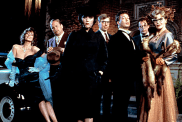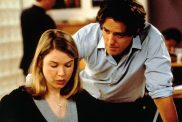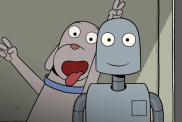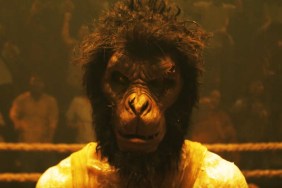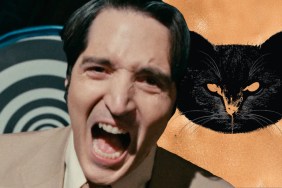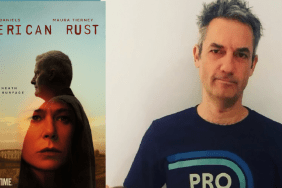It’s been twelve years since Die Hard with a Vengeance, the third installment in the “Die Hard” adventures of New York Police Detective John McClane, still the most famous and popular character that Bruce Willis has played. Willis has made literally dozens of movies since then but the world of technology has changed a lot as well, and one of the more recent developments in internet communication is Second Life, a 3D virtual environment where people can meet, chat, interact and in this case, hold a global press conference where people from all over the world can ask questions of Bruce Willis himself.
ComingSoon.net was invited to take part in this special event and after figuring out how to get around (and sit down), we were able to listen in as Willis answered the questions posed by select Second Life contest winners about his popular character and why he thinks Live Free or Die Hard will be the best movie in the franchise since the first movie. What follows are some of the highlights of the event, which was moderated by “Rockwell Jackalope.” (Thanks to “Dannyboy Lightfoot” for his help and patience in getting ComingSoon.net set-up in Second Life’s virtual world for this event.)
Second Life: It’s been said by some that after John Wayne, John McClane is the quintessential American hero. What is it about the character and why do you think people relate to John McClane in the way that they do?
Willis: Well, I think that a big part of what initially went into the character of John McClane back in 1986-7, was the fact that I had only done a couple of films and a big part of my character was informed by my South Jersey roots, working-class background, a very healthy disregard and lack of respect for authority, and a pretty dark sense of humor. I never consciously thought that I wanted to play it as an everyman but it just kind of turned out like that.
Second Life: You sort of answered this, but what do you have in common with John McClane?
Bruce Willis: What do I have in common? Well, part of what we have started calling the mythology of “Die Hard,” includes the following: As I said, a healthy disregard and disrespect for authority and kind of a cop gallows sense of humor. John McClane loves his family first and truth second. He has zero tolerance for anyone that tries to put innocent people in harm’s way and he’ll sacrifice his own life, if necessary, to keep that from happening.
Second Life: Did this police officer’s disregard for authority irk you at all?
Willis: Irk me at all? No, I think that there are a lot of law enforcement officers out there who work according to their own set of what is right and what is wrong, and that doesn’t always include respect for administration cops and people that are higher up the food chain.
Second Life: What made you originally come to the “Die Hard” franchise?
Willis: It was only in retrospect that, having had the opportunity to look at all three films, the first “Die Hard” and the next two instalments, did I realize that I wanted to take one more shot at trying to do what, at the time, I thought would be the last film in the quartet or the quadrilogy, if you will. I wanted to take one more shot at trying to make a film that was at least as good, if not better, than the first film which, by my judgment, is really the only good one, the only great one anyway.
Second Life: You’ve said that this movie is as good as the first. Could you elaborate on that?
Willis: Well, two things. Len Wiseman and I both were of a similar mind in that we wanted the film to have as little CGI effects in it as possible. We wanted the film to be as hardcore as possible and as smashmouth when it came to the violence as possible, to have stunts and kills in the film that were unique, which posed a particular set of problems because you not only had to compete with our own first three films, but with the “Lethal Weapon” series and all the other knock-offs of the “Die Hard” films that have been done since 1986, of which there are many. Not to mention how good stunts and special effects have become on TV shows like “24,” of which I’m a big fan. TV’s come a long way, you know. Special effects, especially CGI effects, have been made much more cost-effective since those days. So Len, I think really more than myself, was really responsible for some of the big set pieces in this film. It wasn’t until I saw the film cut together that I realized how big a part of the mythology of “Die Hard” elevators are. There’s an elevator scene in every one of the films and now, in the fourth instalment, there’s a huge set piece with this ongoing fight that I have with Maggie Q, who plays this expert martial artist. I have to fight her in order to
I actually have to take a tremendous beating in order to give Justin Long time enough to do what he has to do from the technical side.

Second Life: So what was it like having a female villain?
Willis: It was kind of weird. John McClane’s never hit a woman, and I’ve never hit a woman in real life, and fortunately, I never really made contact with Maggie Q, although she made contact with me a couple of times. It’s odd, it’s really odd. John McClane comments on it that he’s never hit a woman, but he’s going to have to make an exception in this case.
Second Life: There was a rumor that you had to take a hiatus because something happened when Maggie Q or her stunt double hit you?
Willis: The stunt double. It was the first shot of the day and Maggie Q’s stunt double just mistimed the stunt and kicked me in the head with two high-heeled boots. I didn’t take a hiatus; I went to the doctor’s, I got stitched up and I took the rest of the day off, but I was back to work the next day. There are a couple of shots actually in this film; I think there’s a shot where I’m talking to Cliff Curtis’s character, who played Special Agent Bowman who was the Head of the FBI in this film, where you can actually see those stitches, you know, in my forehead, around my eyes. The actual stitches from getting kicked in the head, there were about 15 on the outside and about 28 on the inside. When the DVD comes out you’ll certainly be able to see it and see all the
Yeah, the plastic surgeon that sewed me up thought he had a sense of humor and he kind of looked at this cut open and he said, “Okay, now that’s your skin and that red part there is the muscle and that white part down there is your skull.”
Second Life: What kind of energy does a younger director like Len Wiseman bring to the mix:?
Willis: He really brings a fresh set of eyes. He was 16 years old when the first film came out. He admitted to making his own version of “Die Hard,” him and his friends, which we ended up calling “The Len Wiseman 1988 Backyard Die Hard.” He hasn’t shown it to us yet, but he was telling me a little bit about it today and he said that his dad helped him out and they actually figured out a way to kind of rig up some, some
like a poor man’s process of squib hits, little zip lock bags of Hershey’s syrup mixed with food dye and little firecrackers. I don’t recommend this for anybody at home. I would say that. His dad hooked it up to some type of battery and they actually did squib hits, but we’re trying to get him to put it on the supplemental disk.
Second Life: Is there a favorite scene in the movie that you consider as iconic as what was in the first movie?
Willis: Well, I like the first what I call high-tech warfare scene. It’s kind of a running gun battle between John McClane and, at that particular point in the film, unknown high-tech bad guys, assassins who have come to kill Justin Long. I like the kills in that one. There’s a great set piece in the middle of the film which is a very expensive take with Maggie Q that is particularly brutal, and really the only CGI in the film has to do with an F35 which is new version of a Harrier Jet which can hover and stay stationary and move laterally, because there’s some rule about not flying a jet 25 feet off the deck in the streets of downtown Washington, DC. You would think that they would
come on, you know, it’s “Die Hard” and you would think that they would give us a little latitude. But I actually do battle with a, with an F-35 jet, some of which you see in some of the trailers.
Second Life: Well, I’m glad you bring the whole CGI aspect up, because I think what’s so unique in this crowded movie marketplace is the fact that this movie is just all grit in your face, and everything else comparatively is all thrown into a computer and just sort of drummed up, to a certain degree. Here, we’ve got some real grit and some real action.
Willis: And it really is. I would say that if I had to describe this episode of “Die Hard” in any way, in any simple way, it’s an old school action movie. In a sense, Len Wiseman brought “Die Hard” into the 21st century but he also
we also made a very old school film that, the technology aside, could have taken place in the, in the ’80s in terms of the actual fights.

A good example of how far pervasive CGI has gotten in the world of films, I went to see a film with my 13-year-daughter Tallulah, and at the end of the film, I asked her what she thought of it, and she said, “You know, dad, I never really thought any of the characters were in actual danger.” I asked her what she meant, and she said, “Why, I just know that this was all computer-generated images and I know most of the actors were standing in front of a big green screen.” Granted she grew up in a film family but I think a lot of people know that that’s how it’s done, and when you see two guys actually fighting it out, or a guy and an expert martial artist like Maggie Q, you know, actually smashing each other in the face, obviously we’re not really punching each other in the face, but you know that you’re not fighting a computer-generated robot.
Second Life: How do you feel about playing an older version of John McClane?
Willis: There was a time when one of the ideas of doing another “Die Hard” was doing the prequel, “John McClane: The Early Years.” I think I’ve kind of missed that window now unless they come up with some kind of new technology where they can smooth out these wrinkles that I have on my face. But I would do it. I think that I could act it. It’s just a matter of how I look.
Second Life: Now that you’re older, is it harder doing action scenes? How did you get into shape for the new movie?
Willis: Weight training on a regular basis, cardio, just about daily. The idea really was not necessarily that I wanted to look like I was in shape or that I wanted to look chiselled, because I never really take my shirt off in the film, but I needed to get my muscles big enough to protect my bones, so when I was diving off of things onto the concrete floor, my bones wouldn’t break. Less vanity and more safety, I would say.
I just wanted to say that this is actually a very cool way to interact with, not only with my fans, but you know, talk about the film. Doing classic interviews and so-on and talking to reporters and people that have done it over and over for years and talk about over 300 films every year, reporters tend to get jaded and lose interest very quickly.
Second Life: Why did you decide to do this kind of thing in Second Life and other things you’ve been doing on the internet?
Willis: It’s where I get my news, and it’s how I communicate easily 70% of the time. I have to remind myself to actually pick up the phone and make a phone call when I want to talk to people. But I don’t even watch the news on TV anymore. I haven’t watched it for years. It’s because it’s all sensationalized that I think everything has become entertainment, including the news. Ever since they’ve come up with digital television and the 500-channel concept, especially the news outlets have had to compete at a much more strenuous level and the only way they can do that is through sensationalized media. The truth is, more often than not, optional.
Second Life: Will we hear you say “Yippie-ki-yay, Motherf*cker” in the movie?
Willis: Yes, you will.
Second Life: Will Holly McClane ever come back?
Willis: You know, I would really like to see Holly McClane come back. I think it’s, to a certain degree, you’re going to see like a version 2.0 Holly McClane come back in the character of Lucy McClane in this film. Mary Elizabeth Winsted really did her homework on this film and on the whole series of films and her character originally was not even written into the script. I think it was such a good idea for her to be in the film and to be put in jeopardy in the film, because not only does she show up with her own version of the McClane sense of humor, but she does things later in the film that actually helps us win.

Second Life: Will there be a “Die Hard 5” and would you consider filming it in Mexico? (Note: this was obviously from someone in Mexico)
Willis: Well, it would have to be story-driven. I would definitely consider doing “Die Hard 5.” I would consider doing it anywhere; I would prefer to shoot in the United States. I think “Die Hard” has always been an American franchise. I’m certainly not opposed to shooting it in Mexico.
Second Life: What kind of movie would you dream of working on?
Willis: You know, I have a really good career. I guess that I get asked to work in all kinds of films, independent films like “Fast Food Nation.” I get to do big studio films and animated films like “Over the Hedge.” I do voiceovers. I get to work with some of my favorite actors and, and I’ve taken a handful of films simply because of the actors that I get to work with.
Second Life: Who were some of your favorite actors to work with?
Willis: I got to work with Paul Newman, and about a month ago, I had the opportunity to work with Robert De Niro, one of my all-time heroes. I got to work with Dustin Hoffman on a film called “Billy Bathgate.” I got to work with Meryl Streep and Goldie Hawn and Bob Zemeckis on “Death Becomes Her.” There are still a few actors out there that I would like to work with, but
Second Life: Do you have any actors who were heroes or idols as you were growing up that you really admired and said, “Man, if I could be one person in this industry, who would it be?”
Willis: Steve McQueen.
Second Life: Do you have a favorite McQueen movie?
Willis: There’s a handful of them. I’d probably have to say “Bullitt” would be the #1 film, “The Great Escape” is another one. He did a cowboy movie called “Nevada Smith” that’s worth finding, if you can get hold of them.
Second Life: What kind of advice would you give any aspiring actors or actresses that are starting off in this kind of career you have made a living off of?
Willis: I would say that if there’s any other way that you can express yourself as an artist, if you can paint, I would say do that. If you can sculpt, I would say do that. If you can, write, do that. I think acting is a really difficult racket to break into and I would only suggest doing it if you feel that it’s something that you just can’t live without. And if you’re going to do it, I think you’ve got to go to New York and study with a really great acting teacher. I’ve never really been convinced that there are that many great acting teachers in California.
Second Life: Would you ever consider directing films?
Willis: For a long time, I said that I really was having too much fun acting in films and I’ve recently started a new film company with my younger brother and my long time friend and partner, Steven Eaves, called Willis Brothers Films. It’s a couple of different scripts that I actually may get behind the camera and also act in it, sometime over the next couple of years. I’m taking a long break now. By the time this film comes out on June 27th, I’ll have been working on “Die Hard” for a complete year from pre-production, working on the writing, producing the film, acting in the film for close to five months.
Second Life: Would you say that’s about the normal length for a movie of this level or are they usually much shorter in terms of time?
Willis: It’s about the normal length of time for a “Die Hard” film. I would say every “Die Hard” film took anywhere from four and a half to five months to actually shoot, and the post-production time on this one was really tight. They’re still doing the final mix. As a matter of fact I was going to do press today and Len Wiseman was there briefly doing some tests and had to get back to the editing room in the scoring stage. So normally films take about
an average film takes about three months to shoot.

Second Life: When you first started working on the original “Die Hard” did you have any idea of what kind of important piece of pop culture it would become?
Willis: No, I really had no idea. I had already passed on the film and in all honesty, anybody who likes the film and myself owes Cybil Shepherd a big thanks, because had she not gotten pregnant during the shooting of “Moonlighting” and had Glenn Gordon Caron not decided to shut “Moonlighting” down for 11 weeks, I never would have been able to do “Die Hard.” I’m really honored that anyone thinks that the “Die Hard” quadrilogy is a large part of pop history but I’m going to have to agree. I think that the mythology of it is something that’s going to be around for a long time.
Second Life: Yippie-ki-yay to that. Why should we go see “Die Hard”?
Willis: Because, in my humble opinion, it rivals the first film in both content, in its level of violence and just how smart a film it is. Go see the film, and you’ll be very happy with it if you’re a fan of the series.
Live Free and Die Hard opens everywhere on Wednesday, June 27. Yippie-ki-yay!
